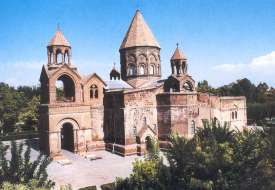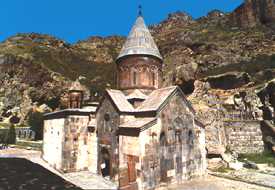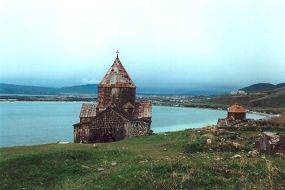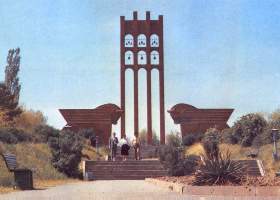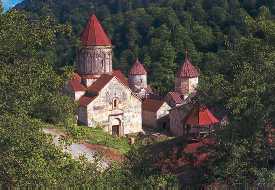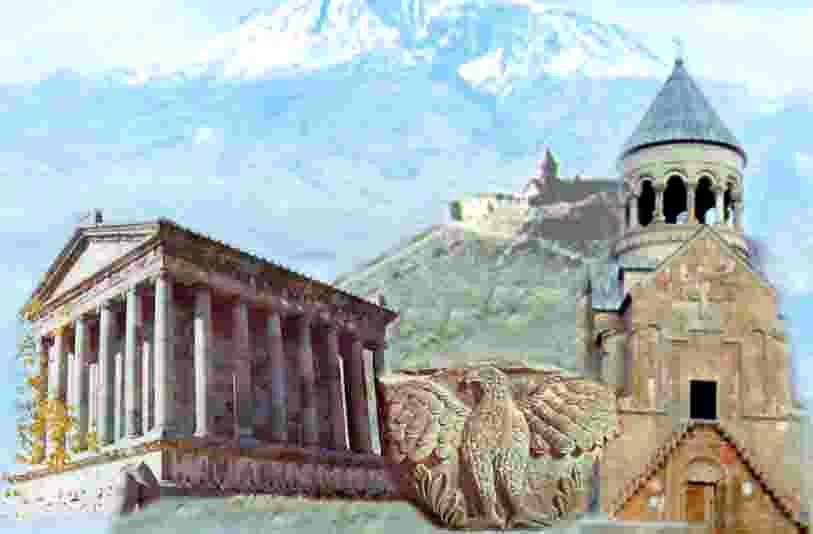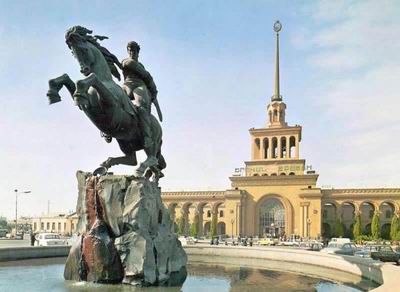


|
|
|
|
ARARAT
ECHMIADZIN
GOVERMENT
GEGARD
SEVAN LAKE
XOR VIRAP
SARDARAPAT
DILIJAN
GARNI & GEGARD
DILIJAN RESORTS
SAGMOSAVANK
HANKAVAN
JERMUK RESORTS
CENTER OF YEREVAN
RAILWAY IN YEREVAN |
"VIEW TO THE PAST" The masterpieces of Armenian architecture and nature are located East of Yerevan. The pagan monastery Garni (3rd Century B.C.) devoted to the Sun God Mitrus is situated on the bank of the Azat River surrounded by steep slopes. What remains of a once mighty fortress is seen on a triangular plateau rising steeply for three hundred meters from the Azat River. It is a basalt monastery majestically built in the Hellenistic style and adorned with huge columns. Armenia is full of miracles, and soon the road beckons you to move on. Before too long you will find yourself in front of a most beautiful and immense sample of medieval Armenian architecture, the Geghard Cave Monastery. The monastery was founded in the 4th Century, but was pillaged by invaders. It was rebuilt again in the 13th Century. Here you will see a lot of cross-stones, which are to be found only in Armenia as well as numerous sculptures and lithographs. Legend says that if you drink the magic water, which comes from the mountains and throw stones into the holes in the hill not far from the monastery, maybe your dreams will come true. HISTORICAL TOURS AND EXCURSIONS No one has counted the churches built in Armenia throughout history. About 15,000 historical monuments are still being erected nowadays on its small territory. Armenia was the first in the world to adopt Christianity as a state religion in 301 A.D. The Armenian Church is described as "Apostolic," since apostles Thaddaeus and Bartholomew preached here in the 1st century A.D. The Holy See of Echmiadzin is the spiritual centre of the Holy Armenian Apostolic Church. According to lore the first Armenian Patriarch, St. Gregory the Illuminator (240-325), had a vision telling that the first Christian church was to be founded in Armenia. The place was subsequently called Echmiadzin, "Descent of the Sole Begotten." "OLD
YEREVAN
" Yerevan, the capital of Armenia is situated in a wonderful geographical location. The panorama of the city is very unique. In front of you from the top of Norq appears a magnificent view of the ancient city of Yerevan, which proudly stands at the foot of the Biblical Mountain Ararat. Yerevan is a sunny city and is spread out on the left and right banks of the Hrazdan River. The rising road from the majestic bridge leads you to the Memorial Complex of Tzitzernakaberd, which is dedicated to the victims of the Great Massacre of 1915. From this spot Yerevan appears in the other side more wonderful and majestic. Next you will visit Matenadaran, a unique museum housing ancient manuscripts. Here you will get to know the soul and mindset of Armenians as most of the manuscripts is the library have the history, which is very close to our biography. Our next stop in the fortress which points to the antiquity of Yerevan. Cuneiform records found here during excavation bear witness that our city is one of the most ancient and was founded in 782 BC. After the excursion you will have the opportunity to admire the rare and great architecture, monuments, sculptures, singing fountains and graceful parks of our wonderful city of Yerevan "CRADLE OF
CHRISTIANITY" Then the road leads you to the ruins of the 7th Century palace Zvartnots or "Palace of Angels" which is of extreme architectural value. Though the palace was destroyed by the earthquake in 930 it still remains the most influential monument with its remaining columns and capitals. Here you can enjoy opera performances staged in the open air. Near the monastery there is a beautiful park where you can have a rest, partake of tasty Armenian cuisine, taste sun ripened fruits, feast your eyes on nature and above, majestic Mount Ararat. Then the road leads you to the ruins of the 7th century palace Zvartnotz or "Palace of Angels" which is the peculiar masterpiece of Armenian architecture. Though the palace is destroyed it remains the most influential (powerful) monument with its sculptural ornamentation of columns and capitals. Here you can enjoy the opera performances in the open air. Near the monastery there is a graceful park where you can have a rest, taste the Armenian cuisine and the sun ripened fruits, admire the nature and the majestic Biblical mountain Ararat. SARDARAPAT The last decisive battle took place here in 1918 against the Turkish conquerors where the Armenian army defeated them. There is a memorial garden with 3500 beautiful roses in memory of the 3500 Armenian soldiers, who gave their lives for their country, their supreme sacrifice. The intoxicating fragrance of roses and the tolling bells calls out to people to remember these brave heroes of Armenia. In the ethnographic museum there are extensive works of folk art on display, including pottery, carpets, musical instruments, tapestry, lace and ceramics. "VALLEY OF FLOWERS" Tsakhkadzor is one of the miracles of Armenia. It is one of the favorite resorts for all seasons, but has also been the summer residence of Armenian Kings for centuries. There is a sporting complex as well as sanatoriums for rest and healing. Kecharis monastery is situated here. "THE PEARL OF ARMENIA" Ages ago "a peace of blue sky" landed on this spot and it is called Lake Sevan It is 1916 m above sea level and is the third highest alpine lake in the world after Titikaka in South America and Poopa in Central America. Standing on a rocky peninsula you can admire the gentle, clear waters as they change color from dark blue to dark turquoise at different times of the day. Sevan has been famous for it's fish "ishhan" which means "prince of fish" in Armenian. It is also a popular holiday resort with its pure air and sandy beaches. King Ashot the 1st and his daughter Mariam founded a monastery here in 874 A.D., which is very interesting. Archeological expeditions indicate that there was a highly developed civilization on the shores of Sevan as far back as 2000 B.C. Unfortunately in recent times the water level of the lake has fallen due to power stations and irrigation canals that were built on the Hrazdan River. However the waters from the Arpa River have been redirected into Sevan to prevent further falling of water levels by means of a tunnel drilled into the basalt rockbed. "ARMENIAN
SWISSLAND" Another miracle of Armenia 's nature is situated north-east of Yerevan on forest covered mountains, and it is called the Dilijan health resort. Dilijan is famous for its thick forests, air with ultra-violet rays, mineral waters and warm sunny days. Tree valleys and two rivers merge together here. Since ancient times the valley of Dilijan has been one of the main stations on the historical Silk Road. Picturesque Clear Lake, a natural pearl of nature is located 8 km from Dilijan. You will be able to rest among pine trees, oak forests and lovely small lakes, impenetrable mountain cliffs and bottomless canyons. The history, culture and creative genius of the Armenian people are visible in the huge and historic monuments such as the famous Goshavanq, Haghartsin, Jukhtak Vanq, and Matosavanq monasteries. "TRIP THROUGH
ERAS" The city of Ashtarak, one of the oldest historical and cultural centers in Armenia is about 20 km from Yerevan located in a gorge at the base of Mount Aragats. While visiting here
you will be acquainted with the millennia-old history of Armenia, feel
the breath of prehistoric days, be able to touch ancient artifacts, see various
types of construction and many churches as well as a Bronze Age settlement and
cromlechs. The bridge
of Kasakh dating from
1664A.D. will tell you about bridge construction from this era. BJURAKAN
OBSERVATORY The highest point in Armenia is Mount Aragats at a height of 4095m above sea level. The mountain is of volcanic origin and has four peaks. Stone Lake, which has fresh water, is 3200m above sea level. The temperature in August is in the +90C range. There are many waterfalls, mountain lakes, alpine fields and spas in this area. Of interest to many is the geology and esthetic beauty. Experienced climbers can go to the summit, admire the surrounding panorama and gather snow in August. Scientific institutions are also located here. North of Yerevan sits the famous and big village of Bjurakan, the summer home to Armenian Catholicos. In this graceful and secluded nook stands the widely known observatory of Bjurakan, which was built in 1946. As you travel further the road leads you to Hamberd fortress, which stands at an elevation of 2300m above sea level founded in the 7th Century. Armenia considers this to be the only preserved monument of a secular type on its territory. The church inside the fortress was built in 1026, the date being inscribed on the door. Hamberd fortress was set on fire and destroyed by the Mongolian invaders in the 13th Century. The interesting part about the Hamberd fortress is the harmonius blanding of its medieval architecture with the mountainous cliffs that dominate the surrounding area. "SYMPHONY OF
STONES" Khor Virap Monastery located 60 km south of Yerevan, is revered by Armenians all over the world as a place of pilgrimage. History states that the pagan Armenian King Trdat the 3rd imprisoned Saint Gregory the Illuminator for preaching Christianity as the state religion in Armenia. From here one can see the fabulous Mount Ararat where the Bible states that Noah's Ark landed after the flood. The Arax River is close by. Afterwards you will be able to taste unique Armenian cuisine in Areni village and drink Areni wine, said to the best in all of Armenia. From Areni we continue on the road through narrow red canyons to Noravanq Monastery. Dating from the 13th-14th Century. The relief on the church entrance and the windows on the west facade are architecturally very interesting. There are also recently discovered stalactite caves. Noravanq Monastery has been completely reconstructed and reopened to the public in 1999. The mountainous landscape, which surrounds, the Monastery displays a beautiful myriad of colors from the sun's reflection.
Welcome in Armenia !!!
|

Copyright(c) 2003 Viagra Tour LLC. All rights reserved.
viagratour@rambler.ru






 EXCURSIONS
EXCURSIONS

